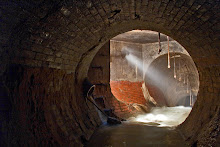I am going to discuss the passage which starts at the top of p.49. My passage ends "Thunderous applause greeted him at the far end". This passage deals with the opening of the Prince Edward Bridge, and whom crossed it first.
I have selected this passage as it deals primarily with the question of whose 'history' is important, and how 'history' is recorded.
In this passage, Ondaatje deliberately draws emphasis to a hierarchy of importance. The bridge in question is named 'Prince Edward', after Prince Edward Winsor VIII. Of similar importance the first 'official' party to cross over the newly opened bridge are "a show car containing officials". Both of these parties are anonymous in the novel, and little attention is drawn to them. Instead, Ondaatje draws the reader's attention to a cyclist who breaks though police cordons to be the first to cross the bridge. He then goes even further, by stating that, even before the cyclist broke though "The previous midnight workers had arrived" in preparation for the ceremony.
By doing this, Ondaatje restructures the hierarchy of importance for the reader. Whilst the officials who visit the bridge, and the Prince of England are 'officially' and 'historically' the most important participants in the bridge, it is in fact the construction workers whom, Ondaatje clearly believes are the real heroes of the construction of the bridge, whilst the lone cyclist is the first 'official' person to cross the bridge, and not the 'important' officials. Ondaatje goes even further, suggesting that these individuals are overlooked by history – the workers on the bridge cross "at midnight", suggesting that they are both literally and hypothetically unseen. Likewise, the cyclist whom crosses the bridge first is shown on photographs merely recorded by photographers as "a blur of intent"
The theme of unlikely or overlooked individuals is one seen throughout Ondaatje's novel. Rather than focus on the "single story" of great figures. Whilst making reference to ‘important’ figures (such as the politicians in the car, Prince Edward, or Amrose the millionaire) Ondaatje also draws the reader’s attention to characters such as, Patrick the industrial worker, Nicolas the immigrant, a lone cyclist, or Caravaggio the common thief. In doing so, Ondaatje forces the reader to reassess the importance of historically defining individuals, in comparison to historically overlooked or undervalued groups. This multifaceted approach to narrative underlines the importance of the individual whilst simultaneously eroding the importance of status. By doing so, Ondaatje suggests that the individual or background figures are equally, of not more importance in understanding and defining a ‘history’ as the ‘great’ leaders and figures. In a country where a national identity is so fragile and recent, an understanding of shared ‘history’ and heritage must be incredibly important to Canadians, and by offering multiple stories, Ondaatje makes good on his promise from the start of the novel that "Never again will a single story be told as though it were the only one".
Subscribe to:
Post Comments (Atom)

3 comments:
This is a nice point about the official vs. unofficial stakeholders in the bridge, and how Ondaatje inverts the usual pattern of representation. I am reminded of a photograph called The Last Spike which you might have come across – it’s a picture of dignitaries standing around the Canadian Pacific Railway, and one particularly important official is ostensibly knocking in the ‘last spike’ – the last metal staple on the last sleeper of the railway linking western Canada to eastern Canada. There are, of course, none of the Chinese workers who worked at below-freezing temperatures and in perilous conditions to build the rest of the CPR in the photo …
(I notice you have ‘history’ in quotation marks – is this just for this course or is this how you have begun to think of history?!)
I like the passage you chose as well because, as you said, it explicitly questions the validity of hierarchy. It juxtaposes the 'official' history with the disregarded 'real' history which belongs, in Ondaatje's novel, to the workers. Those workers, as well as the immigrants in Canada in general, are not part of the 'official' history; they are not given a voice. Nevertheless, they form a crucial part in contributing to Canada's past, present and future. Even though this minority tends to be ignored by the dominant culture they manage to find their own way into 'official' history and reality which they are in fact part of. The way the cyclist is described as being "the first member of the public" crossing the bridge before the "officials" evoked a feeling of schadenfreude in me. It is somehow satisfactory to see the presumptuous officials being tricked by an "anonymous" cyclist. This example shows very well that it is also possible for underdogs to find their voice if they are determined to do so - or metaphorically speaking if they are "cycling like hell".
Sorry I'm a bit late in writing this reply. I agree with most of what you said. i liked the fact that the crowd cheered for the cyclist, it showed that he spoke as the voice. The other thing i think it's relevent for, is the imagery. the idea of the cyclist ruining the perfect road with his bikes wheels, he's painting on a fresh kanvas both literally and figuratively. On one hand he writes the "other" history by being the first to cycle over it, and literally any mark he leaves is on the road is on fresh kanvas.
Post a Comment